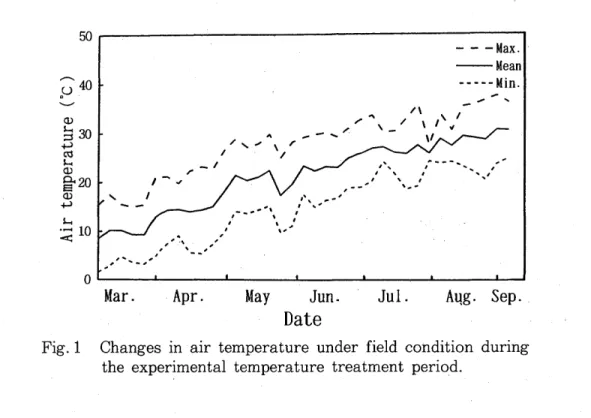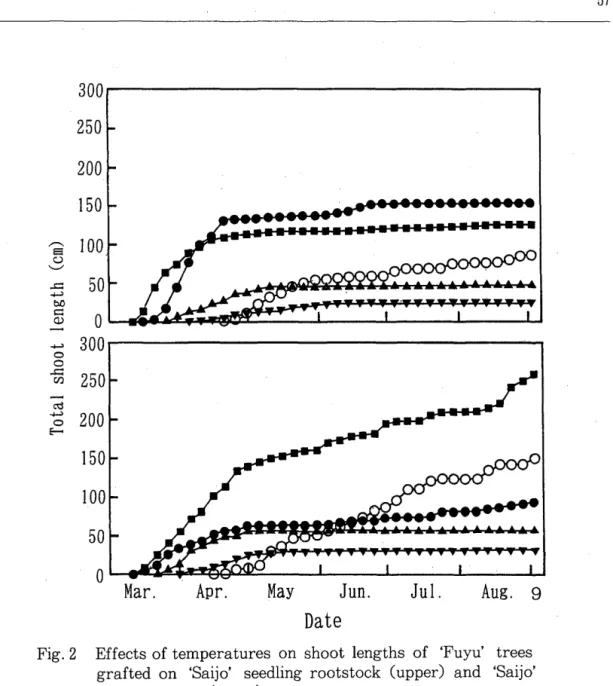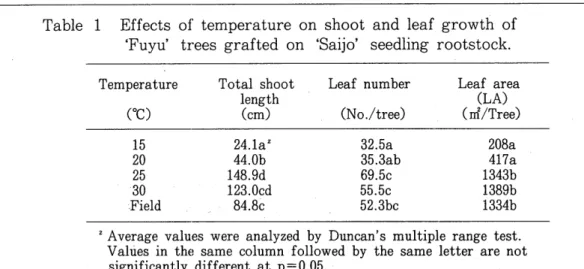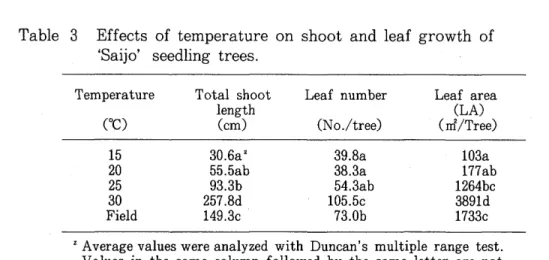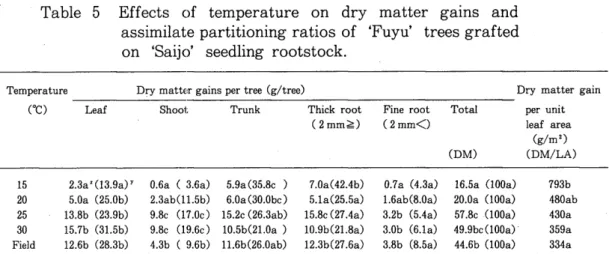Effects of Temperature on Growth, Dry Matter Production and Assimilate Partitioning of Japanese Persimmon
(DiosJPyros kakiL.) cv.Fuyu trees
Masahiko Fum uro 1 and Hiroshi Inoue 2Abstract
The effects of temperature on the growth, dry matter gain (DMG) and assimilate partitioning ratio (APR) in one-year-old Japanese persimmon (Diospyros kaki L.) 'Fuyu' trees grafted on 'Saijo' seedling rootstocks were investigated. The trees were grown in a growth chamber (natural daylight; relative humidity 75%) in which the temperature was kept constant at 15, 20, 25 or 30°C, or under field conditions from 1 March to 2 September, 1997. 'Saijo' seedling trees grown in plastic pots were also examined for comparison.
The values of total shoot length, and fresh and dry weights of each organ, were the highest at 25 or 30°C in 'Fuyu' trees, and at 30°C in 'Saijo' seedling trees.
DMG of tree was the highest at 25 - 30°C in 'Fuyu' trees, and at 30°C in 'Saijo' seedling trees, although DMG per unit leaf area was higher at lower temperatures.
In 'Fuyu' trees, APR to shoot was similar at 25 and 30°C. However, in 'Saijo' seedling trees, APR to shoot was clearly higher at 30°C than at 25°C.
Introduction
Since PCNA cultivars requIre a warm temperature, to naturally remove their astringency, they are rnainly cultivated in areas where the mean annual temperature is 14 - 16°C (19). In 'Fuyu' trees, several studies on the effects of temperature have been made on fruit growth and quality (2, 3, 4), but a few on tree growth (8). To examine the effect of temperature on the growth of 'Fuyu' trees, the effect of temperature on the growth of rootstock should also be examined, because all scion cultivars are grafted on rootstocks for propagation.
George et a1. ( 8) reported the effects of day-night temperatures in the glasshouse on the growth and fruit SE~t of 'Fuyu' trees, but not the growth of the rootstock tree. The amount of tree growth is indicated by DMG, which is largely influenced by the dry matter productivity of the leaves. However, studies on the effects of temperature on dry matter production and assimilate partitioning have not been reported in Japanese persimmon trees.
This study was conducted to reveal the effects of temperature on growth, dry matter production and assimilate partitioning in 'Fuyu' trees grafted on 'Saijo' seedling rootstocks in c01nparison with those in 'Saijo' seedling trees.
Materials and Methods
One-year-old Japanese persimmon (Diospyros kaki ,L.) 'Fuyu' trees grafted
1. Horticultural Branch, Shiga Prefectural Agricultural Experiment Station, Shiga, 520-3003, Japan 2. Department of Biotechnological Science, Kinki University, Wakayama, 649-6493, Japan
on 'Saijo' seedling rootstock and one-year-old 'Saijo' seedling trees grown at the Faculty of Biotechnology Oriented Science and Technology, Kinki University, Wakayama Prefecture, were used. They were grown in plastic pots (5 liters).
filled with a mixture of vermiculite and peatmoss (1 : 1 v / v). From 1 March (before sprouting) to 2 September (end of shoot growth), 1997, these trees were placed in growth chambers (75% relative humidity, natural daylight) controlled at 15, 20, 25 or 30°C, or left in the field. Four trees were used for each temperature treatment. These trees were fertilized with a lON-lOP-10K liquid fertilizer at intervals of 1 - 2 weeks, and chemicals to control diseases and pests were applied occasionally on demand. Air temperatures under field conditions during the experimental period are shown in Fig. 1.
50~---'
-- 40 aU
<J)
S
30f-l Cd J-. <J)
~20
<J)
f-l
:';;10 J-.
,--.,
r" ., , '\
,.... "
" .... -,
1 ' " " , \ /
1 /
_ I
" ~ I'
---
...".
,-, ,
'\ ,
'\~ ~
- - -Max ..
--Mean ---Min.
..
,....
'O~--~---~--~----L--_~---~~
Mar. Apr. May Jun. Jul.
Date
Fig. 1 Changes in air temperature under field condition during the experimental temperature treatment period.
1 . Shoot elongation and dry weight of each organ
Total shoot lengths of all trees were measured at 5 -day intervals from 1 March to 2 September. On 2 September, the number of leaves per tree, and leaf area were measured by automatic leaf area meter (Model AAM- 7 , Hayashi Denko Co.). Then, all trees were separated into trunks, branches, leaves, thick roots,
(~ 2 mm in diameter) and fine roots (
<
2 mm in diameter), and their fresh weights were measured. They were then; dried in a drying oven at 75°C until reaching constant weights to obtain dry weight.2. Dry matter production and assimilate partitioning
DMG of trunk was estimated as follows. Diameters at the base and top of each trunk were measured at the beginning (1 March) and the end (2 September) of the temperature treatment period. Regarding the transverse section as a circle,
the areas of the transverse sections at the base and top were calculated. The ratio of the value at the base to that at the top was regarded as the trunk increment ratio, because the trunk length during the experimental period was nearly the same.
Trunk fresh weight at the beginning of temperature treatment was estimated by dividing the trunk fresh weight ·at the end of the treatment by the trunk volume increment ratio mentioned above. Trunk dry weight was calculated by multiplying the calculated fresh weight by dry weight ratio of the trunk.
In 'Fuyu' trees, thick root dry weight is closely correlated with total dry weight of scion (7). Therefore, the thick root fresh weight at the beginning of temperature treatment (1 March) was calculated by dividing the thick root dry weight measured at the end of the treatment by the trunk dry weight increment ratio.
Dry weight increment of trunk and that of thick root during temperature treatment was calculated as the difference between the dry weight· measured at the end of the treatment and the estimated initial dry weight. To obtain dry matter gain per tree during the temperature treatment period, dry weights of leaves (including fallen leaves), branches and fine roots were added to the dry weight increments of trunk and thick roots. DMG per unit leaf area was calculated by dividing Dlv1G of tree by total leaf area per tree.
APR was shown by percentage of the dry weight increment of each organ to DMG of tree.
Results
1 .
Shoot elongation and dry weight of each organ 1. 1. 'Fuyu' tree grafted on 'Saijo' seedling rootstockThe higher the temperature, the earlier the sprouting in 'Fuyu' trees, in this experiment. At 30°C, the. period required for sprouting from the start of temperature treatment was only 10 days, i. e., about one-third of that at 15°C.
The trees left in the field s'prouted 45 days after the start of the treatment. Total shoot length per tree was the longest at 25 or 30°C followed by 20°C, but was short at 15°C. Leaf number and leaf area per tree were higher at 25 or 30°C, and lower at 15 or 20°C. Total shoot length and the leaf number per tree of the trees left in the field were between the values at 20 and 25°C (Fig. 2, Table 1).
300 250 200 150
"... e
100
C,) '--"
..c:
~
bD I:::
0
Q)
~
300
0
..c: 0
250
CI)
cd
~ 0
200
E-
150 100 50
0
Mar. Apr. May Jun. Jul. Aug. 9Date
Fig. 2 Effects of temperatures on shoot lengths of 'Fuyu' trees grafted on 'Saijo' seedling rootstock (upper) and 'Saijo' seedling trees Clower) .
.... : 15°C, . : 20°C, • : 25°C, • : 30°C, 0: field condition
Table 1 Effects of temperature on shoot and leaf growth of 'Fuyu' trees grafted on 'Saijo' seedling rootstock.
Temperature Total shoot Leaf number Leaf area
length (LA)
(Oe) (cm) (No./tree) (rrl/Tree)
15 24.1az 32.5a 208a
20 44.0b 35.3ab 417a
25 148.9d 69.5c 1343b
30 123.0cd 55.5c 1389b
Field 84.8c 52.3bc 1334b
Z Average values were analyzed by Duncan's multiple range test.
Values in the same column followed by the same letter are not significantly different at p=0.05.
The values of fresh weight per tree, fresh weights of leaves, shoots and thick roots per tree, dry weight per tree, and dry weights of leaves, branches and thick roots per tree were higher at 25 or 30°C than at 15 or 20°C. Fresh and dry weights of the trees left in the field were between the values at 20 and 25°C (Table 2).
Table 2. Effects of temperature on fresh and dry weight of 'Fuyu' trees grafted on 'Saijo' seedling rootstock.
Temperature Above-ground part (g) Under-ground part (g) Whole tree
cae)
Leaf Shoot Trunk Total Thick root -Fine root Total (g) (2 mm~) (2 mm<)Fresh weight(g)
15 6.5az 1.9a 45.7a 54.1a 52.1a 1.9a 54.0a 108.1a
20 18.4a 5.4a 49.0a 72.8a 52.9a 4.6ab 57.5ab 130.3a 25 46.1b 20.9b 58.4a 125.4b 74.1b 9.0bc 83.1c 208.5b 30 45.2b 22.8b 50.3a 118.3b 71.9b 8.7bc 80.6c 198.9b Field 39.0b 9.6a 52.0a 100.6b 66.2ab 10.9c 77.1bc 177.7b Dry weight (g)
15 2.3a 0.6a 19.9a 22.8a 23.2a 0.7a 23.9ab 46.7a
20 5.0a 2.3ab 24.6ab 31.9a 20.9a 1.6ab 22.5a 54.4a
25 13.8b 9.8c 32.9c 56.5c 34.4b 3.2b 37.6c 94.1b
30 15.7b 9.8c 26.6bc 52.1bc 27.7ab 3.0b 30.7bc 82.8b Field 12.6b 4.3b 26.8bc 43.7b 28.1ab 3.8b 31.9bc 75.6b
Z Average values were analyzed by Duncan's multiple range test. Values in the same column followed by the same letter are not significantly different at p=0.05.
1. 2. 'Saijo' seedling trees
The higher the temperature, the earlier the sprouting, as in 'Fuyu' trees grafted on 'Saijo' seedling rootstocks. The values of total shoot lengths and leaf areas per tree were the highest at 30°C followed by 25 or 20°C, but was very low at
15°C. Leaf number per tree was the highest at 30°C followed by 25, 20 and 15°C, in this order. Total shoot length, leaf number and leaf area of the trees left in the field were between the values at 25 and 30°C (Fig. 2, Table 3).
Table 3 Effects of temperature on shoot and leaf growth of 'Saijo' seedling trees.
Temperature Total shoot Leaf number Leaf area
length (LA)
coe)
(cm) (No./tree) (rrf/Tree)15 30.6a Z 39.8a 103a
20 55.5ab 38.3a 177ab
25 93.3b 54.3ab 1264bc
30 257.8d 105.5c 3891d
Field 149.3c 73.0b 1733c
Z Average values were analyzed with Duncan's multiple range test.
Values in the same column followed by the same letter are not significantly different at p=0.05.
Fresh weight per tree, fresh weights of each organ, dry weight per tree, and dry weight of each organ were the heaviest at 30°C followed by 25°C. The values at 20 and 15°C were very low. Fresh and dry weights of trees left in the field were between the values of 25 and 30°C (Table 4).
Table 4 Effects of temperature on fresh and dry weight of 'Saijo' seedling trees.
Temperature Above-ground part (g) Under-ground part (g) (ae) Leaf Shoot Trunk Total Thick root Fine root Total
(2 mm~) (2mm<) Fresh weight (g)
15 2.3az 1.2a 18.2a 21.7a 47.2a 1.3a 48.5a
20 4.0a 2.0a 18.4a 24.4a 37.6a 0.9a 38.5a
25 35.4b 9.7ab 20.3a 65.4b 46.7a 7.0a 53.7a
30 94.1c 64.0c 35.7b 193.8c 77.5b 31.4c 108.9c Field 44.2bc 16.9b 23.4a 84.5b 66.8b 19.7b 86.5b Dry weight (g)
15 0.8a O.4a 10.3a 11.5a 21.1bc 0.5a 21.6a
20 1.4a "1.0a 9.6a 12.0a 14.3a 0.3a 14.6a
25 9.9b 4.3ab 10.8a 25.0b 17.3ab 2.5a 19.8a
30 28.4c 28.5c 18.5b 75.4d 26.2c 11.0c 37.2b
Field 13.9b 7.5b 12.8a 34.2c 25.7c 6.9b 32.6b
Whole tree (g)
70.2a 62.9a 119.1b 302.7d 171.0c 33.1a 26.6a 44.8b 112.6d 66.8c
Z Average values were analyzed by Duncan's multiple range test. Values in the same column followed by the same letter are not significantly different at p=0.05.
2. Dry matter production and assimilate partitioning 2. 1. 'Fuyu' tree grafted on 'Saijo' seedling rootstock
DMG of tree at 25 and .30°C were higher than that at 15 and 20°C. On the contrary, DMG per unit leaf area was the highest at 15°C. In the trees left in the field, DMG of tree was between the values at 20 and 25°C, and DMG per unit leaf area was similar to that at 30°C (Table 5). At 25 and 30°C, APR to shoot was higher and the ratios to trunk and thick root were lower than the ratio at 15°C.
APRs to each organ of the trees left in the field were similar to the values at 20 and 25°C (Table 5).
Table 5 Effects of temperature on dry matter gains and assimilate partitioning ratios of 'Fuyu' trees grafted on 'Saijo' seedling rootstock.
Temperature Dry matter gains per tree (g/tree) Dry matter gain
cae) Leaf Shoot Trunk Thick root Fine root Total per unit
(2 mm~) (2mm<) leaf area (g/m2)
(DM) (DM/LA)
15 2.3a Z C13.9a) Y 0.6a ( 3.6a) 5.9a (35.Bc ) 7.0a( 42.4b) 0.7a C4.3a) 16.5a (lOOa) 793b 20 5.0a (25.0b) 2.3ab(11.5b) 6.0a (30.0bc) 5.1a(25.5a) 1.6ab(B.Oa) 20.0a (lOOa) 4BOab 25 13.8b (23.9b) 9.Bc (l7.0c) 15.2c (26.3ab) 15.Bc (27.4a) 3.2b (5.4a) 57.8c(l00a) 430a 30 15.7b (31.5b) 9.8c (19.6c) 1O.5b(21.0a ) 10.9b(21.8a) 3.0b (6.la) 49.9bc(100a) . 359a Field 12.6b (2B.3b) 4.3b ( 9.6b) 11.6b(26.0ab) 12.3b(27.6a) 3.Bb (B.5a) 44.6b (IOOa) 334a
Z Average values were analyzed by Duncan's multiple range test. Values in the same column followed by the same letter are not significantly different at p=O.OS.
Y Numbers in parenthesis indicate assimilate partitioning ratios.
2. 2. 'Saijo' seedling tree
DMG of tree was the highest at 30°C followed by 25°C, and was low at 15 or 20°C. On the other hand, DMG per unit leaf area was the highest at 15°C followed by 20°C, and was low at 25 or 30°C. In the trees left in the field, DMG of tree was between the values at 25 and 30°C, and DMG per unit leaf area was similar to that at 25 or 30°C (Table 6). APR to leaves was higher at 25 or 30°C than at 15 or 20°C. At the temperature between 20 and 30°C, the higher the temperature, the higher the APRs to shoot and fine root, and lower the APRs to trunk and thick root. APRs to each organ of the trees left in the field were between the values at 25 and 30°C (Table 6).
Table 6 Effects of temperature on dry matter gains and assimilate partitioning ratios of 'Saijo' seedling trees.
Temperature Dry matter gains per tree Cg/tree) Dry matter gain
COC) Leaf Shoot Trunk Thick root Fine roo~ Total per ',unit
(2mm~) (2mm<) leaf area Cg/m2)
(DM) (DM/LA)
15 0.8a Z C 7.8a) Y OAa C 3.9a) 2.8aC27.5c) 5.!aC55.9d ) 0.5aC 4.9ab) ,lO.2aClOOa) 990c 20 l.4a C12.5a) l.Oa ( 8.9a) 3Aa(30Ac) 5.1aC45.5c ) 0.3a( 2.7a ) 1l.2a Cl OOa), 633b 25 9.9b C36.7b) 4.3abC15.9b) 4.0aCl4.8b) 6.3aC23.3b ) 2.5aC 9.3bc) 27.0bClOOa) , 214a 30 28Ac (33.8b) 28.5c C34.0c) 6.6bC 7.9a) 9.5bCll.3a ) 1l.0cC13.0cd) 83.9dCI00a) 216a Field 13.9b (36.6b) 7.5b C19.7b) 3.2aC 8Aa) 6.5aC17.1ab) 6.9bC18.2d ) 38.0c C 1 OOa) 219B.
Z Average values were analyzed by Duncan's multiple range test. Values in the same column followed by the same letter are not significantly different at p=0.05.
Y Numbers in parenthesis indicate assimilate partitioning ratios.
Discussion
Japanese persimmon cultivar 'Fuyu' require warm temperature, higher than about 25°C, for natural removal of astringency, but the optimum temperature for the growth and quality of fruit was 20 to 25°C (2, 3). Therefore, this cultivar has been cultivated mainly in a warm climate such as Fukuoka, Gifu, Nara and Wakayama Prefectures. George et al. ( 8) reported that the tree growth was more vigorous at a higher temperature, and that the shoot dry weight, leaf number and leaf area were the highest at day/night temperatures of 32/27°C. Persimmon trees are highly resistant to summer heat, tolerating the high temperature up to 50°C, and have a high optimum night temperature (32°C) for vegetative growth (15). In addition, even at the temperatures higher than 30°C, cell division in the root tips continues (5). Thus, 'Fuyu' trees appear to require a relatively high temperature for vigorous tree growth. In this investigation also, a relatively high temperature stimulated tree growth of 'Fuyu' trees grafted on 'Saijo' seedling rootstocks.
The shoot elongation period in 'Fuyu' trees is about 6 - 7 weeks and the rates of shoot elongation is the greatest during a month after the sprouting, and thereafter rapidly decline (16). In this experiment, the shoot elongation of 'Fuyu' trees left in the field were the greatest during a month after sprouting, and approximately finished at 45 days after sprouting. In regard to relationship between temperature and shoot elongation, it was found that the higher the temperature, the earlier the sprouting, and that the shoot elongation period after the sprouting were 40 - 45 days except 60 days at 15°C. The shoot discontinue elongating by self pruning, however leaf primordium in the axillary bud were completed by August in the previous year (9). Consequently the shoot length was depended on the self pruning date and the internode elongation. The excellent shoot length at a relatively high temperature might be attributed to the late self pruning date and the vigorous internode elongation during shoot elongation period.
In this experiment, the temperature was kept constant, but George et al. ( 8 )
gave the diurnal temperature fluctuation of 5°C in their experiment. The effects of difference between day and night temperatures (DIF) on the growth of annual flowers have been investigated, and a positive DIF (day temperature
>
night temperature) promoted the increase in plant height and internode length (11).A positive DIF might also influence the growth of 'Fuyu' trees. A high soil temperature can advance bud growth break, root and shoot growth (15). In this experiment, the temperature of the under-ground part of one-year-old potted 'Fuyu' trees in growth chambers was supposed to be similar to that of the above- ground part. In the future, the effects of soil temperature on the growth of 'Fuyu' trees should be examined.
There are not many studies on the photosynthetic rate in Japanese persimmon trees ClO, 12). These studies showed that the photosynthetic rate of 'fuyu' tree was the highest in early August, thereafter gradually continued to decrease until the leaf fall stage, but did not reveal the rerationship between temperature and photosynthetic rate. In this study, the photosynthetic rate was not investigated, however studied the effects of temperature on DMG of tree. As a result, DMG of tree was higher at a relatively high temperature. It is supposed that the higher DMG were caused by acceleration of the photosynthetic rate at a relatively high temperature.
There are also very few studies on the effects of rootstocks on photosynthesis in Japanese persimmon too. However, in some rootstck studies of citrus it was revealed the effects of different rootstocks on growth, photosynthesis and distribution of photosynthetic product of trees (13, 17). The effects of 'Saijo' rootstock on photosynthesis of the scion cultivar, 'Fuyu' tree is not clear from this experiment, but it is supposed that rootstock influence tree growth and response to temperature.
In 'Saijo' seedling trees, the tree growth was excellent at 30°C, and the optimum temperature for tree growth was somewhat different from that of 'Fuyu' trees grafted on 'Saijo' seedling rootstocks. Responses to temperature of 'Fuyu' trees grafted on 'Saijo' seedling rootstock may somewhat differ from that of 'Saijo' seedling trees.
DMG of tree was excellent at 25 or 30°C in 'Fuyu' trees grafted on 'Saijo' seedling rootstocks, and at 30°C in 'Saijo' seedling trees. In 'Fuyu' trees, APR to shoot was similar at 25 and 30°C. However, in 'Saijo' trees, APR to shoot was clearly higher at 30~C than at 25°C. .
DMG has been reported to be proportional to the leaf area or leaf dry weight in grapevine (18) and Japanese pear (1, 6). In this experiment, DMG of 'Fuyu' trees grafted of 'Saijo' seedling rootstocks and that of 'Saijo' seedling trees were proportional to the leaf dry weight of each tree. In addition the lower the temperature, the higher DMG per unit leaf area presumably due to reduced consumption of photosynthates at low temperatures. Morinaga et al. (14) reported that the lower the temperature, the less the respiratory rate in each organ and the gross respiratory carbon consumption in the whole 'Fuyu' tree. The high APR to shoot at relatively high temperatures (25 or 30°C) may have resulted from the accelerated shoot elongation, and the low APR to trunk or thick root at relatively high temperatures from a high APR to shoot and leaf.
'Fuyu' trees grafted on 'Saijo' seedling rootstocks grew well at a relatively high temperature, but ' Saijo' seedling trees grew vigorously at a higher temperature (30°C). The differences in the effect of temperature on the tree growth between 'Fuyu' trees grafted on 'Saijo' seedling rootstocks and 'Saijo' seedling trees might be due to genetic differnce between two cultivars, or physiological difference between the juvenile phase in the seedling tree and the adult phase in the grafted tree. Japanese persimmon is difficult to propagate by cutting. After successful growth of self-rooted 'Fuyu' trees by cutting, we will investigate the effects of temperature on the growth of the trees grafted on rootstocks in comparison with that on the growth of the self-rooted trees.
References
( 1) Azukizawa, H., Ito, T. (983) Net production and absorption of nourishment on Nijisseiki pear. (In Japanese). Bull.Shimane Pref.Agr.Expt.Sta.18, 31- 4 7.
( 2) Chujo, T., Kataoka, M., Yamauchi, S., Ashizawa, M. (1972) Effect of tempe- rature on the growth and quality of Kaki fruit. 1. On the temperature treatment during the stage of fruit enlargement. (In Japanese). J. Japan. Soc.
Hort. Sci. 41, 339-343.
( 3) Chujo, T., Hashimoto, T., Ashizawa, M. (973) Effect of temperature on the growth and quality of Kaki fruit. 2. On the day and night temperature treatment during the stage of fruit enlargement. (In Japanese). Bull. Fac.
Agr. Kagawa Univ. 25, 25-34.
(4) Chujo, T. (983) Studies on the effects of thermal conditions on the growth and quality of Fuyu Kaki. (In Japanese). Mem. Fac. Agr. Kagawa Univ. 37, 1 -62.
( 5) Fukui, H., Mochizuki, K., Nakamura, M. (993) Seasonal changes in cell division in the root tips of Japanese persimmon cv. Nishimurawase. (In Japanese). J. Japan. Soc. Hort. Sci. 62, 359-362.
(6) Fumuro, M. 0997a) Effect of fruit load on the growth, dry matter production and assimilate partitioning of Japanese pear trees cv. Kousui in a sideless plastic house. (In Japanese). J. Japan. Soc. Hort. Sci. 66 (Suppl. 1), 176-177.
( 7) Fumuro, M. 0997b) Relationship between factors of tree canopy composition and dry weights of each organ of Japanese persimmon cv. Fuyu trees. (In Japanese). J. Japan. Soc. Hort. Sci. 66 (Suppl.2) , 202-203.
( 8) George, A. P., Nissen, R. J., Collins, R. J. (994) Effects of temperature and pollination on growth, flowering and fruit set of the non-astringent persimmon cultivar 'Fuyu' under controlled temperatures. J. Hort. Sci. 69, 225-230.
(9) Harada, H. (984) Relation between shoot growth, axillary bud development and flower initiation in Japanese persimmon. (In Japanese). J. Japan. Soc.
Hort. Sci. 53, 271-277.
(0) Hino, A., Amano, S., Sawamura, Y., Sasaki, S., Kurahasi, T. (974) Studies on the Photosynthetic activity in several kinds of fruit trees IT. Seasonal changes in the rate of photosynthesis. (In Japanese). J. Japan. Soc. Hort. Sci.
43, 209-214.
(1) Ito, A., Hisamatu, T., Soichi, N., Nonaka, M., Amano, M., Koshioka, M. (997) Effect of diurnal temperatures alternations on the growth of annual flowers at the nursery stage. J. Japan. Soc. Hort. Sci. 65, 809-816.
(12} Iwasaki, N., Yosida, A. (1996) Differences in the photosynthetic characteristics and tree growth among four' Japanese persimmon cultivarsgrown in warm climate. (In Japanese). J. Japan. Soc. Hort. Sci~ 64, 757-762.'
(13) Morinaga, K., Ikeda, F. (1990) The effects of several rootstocks' on photo- synthesis, distribution of photosynthetic product, and growth of young satuma mandarin trees. J. Japan. Soc. Hort. Sci. 59, 29-34.
(14) Morinaga, K., Yakushiji, H., Koshita, Y. (1998) Respiratory carbon consump- tion in non photosynthetic organ of Japanese persimmon 'Fuyu' .J. Japan.
Soc. Hort. Sci. 67 (Suppl. 1 ), 57.
(15) Mowat, A. D., George, A. P. (1993) Persimmon. In: Handbook of environmental physiology of fruit crops. (Schaffer, B. and Anderson, P. C., Eds.). p209-232.
CRC Press, Boca Raton.
(16) Nii, N. (1980) Current shoot and leaf growth in Japanese persimmon, Diospyros kaki cv. Fuyu, in relation to the development of the tissue system in the leaf. (In Japanese). J. Japan. Soc. Hort. Sci. 49, 149-159.
(17) Phillips, R. L., Castle, W. S. (1977) Evaluation of twelve rootstocks for dwarfing citrus. J. Amer. Soc. Hort. Sci. 102, 526-528.
(18) Takahashi, K. (1986) Studies on the proper yield of grapevine. (In Japanese) . . Bull. Shimane Pref. Agr. Expt. Sta. 21, 1 -104.
(19) Yamada, M. (1994) Persimmon. In : In horticulture in Japan. p47 -52. Asakura
Publishing Co., Ltd. Tokyo. .
;f-.y "fll~O) 1 £F~ '~:fi' ('rffi~' ~~i5') Itt:J $~ 'rffi~' ~~It~#t~L ... 3
Ji
1 B J:. tJ 9
Ji
2 B i 'C' ... 15°C ... 20°C ... 25°Ci> J:. 0'30°CO)'t][iffil~ftj:O)AI~~~ (§?&:J'C ... *13~t111[~75%) ~f5effl L L ~ Ito)~~ ... ~!Im~j£i> J:. O'71~tc&'~~Tiffil~O)~.~~M L t:.o
*JTf~{$~ ... ~~,§O)*JTrfl:i>J:.u'~l/?JJmli ... '~:fi' fMti25°Ct:30°C ... 'rffi~' ~~It'C'ti 30°Cib{~<bflnt:.o 1fiulJ~iIDfl~t:. tJ~!Im~j£.tifg;~'1iffil~'C'~ib~-:> t:.ib{ ... 1 It~t:. tJ~!Im
~1JD.ti ... '~:fi' Itti25°C2:30°C ... 'rffi~' ~~fM'C'ti30°Cib{~<bflnt:.o *JTf~A..0)1DJ1tj£
!1m O)71~c* ti... '~:fi' *it ti25°C t: 30°C ibq~ tIIDJ t.:: 'C' J5 -:> t:. ib{... 'rffi~' ~~fM'C' ti25°C J:. tJ 30°Cib{B)3 S ib~ tc raJib~"? t:.o
